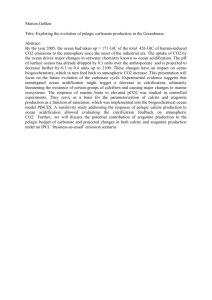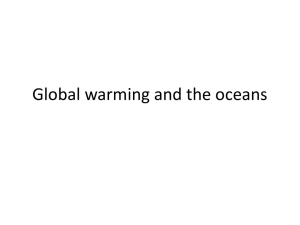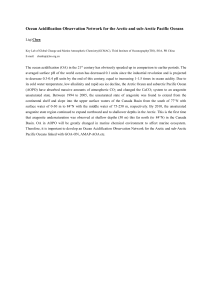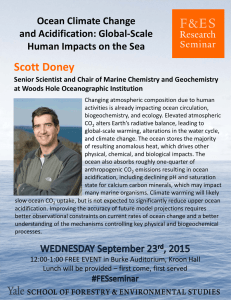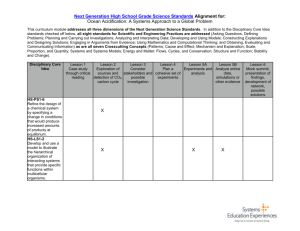3. Benthic calcification in the Dutch Coastal zone and effect on... acidification on the growth of commercially important bivalve species
advertisement
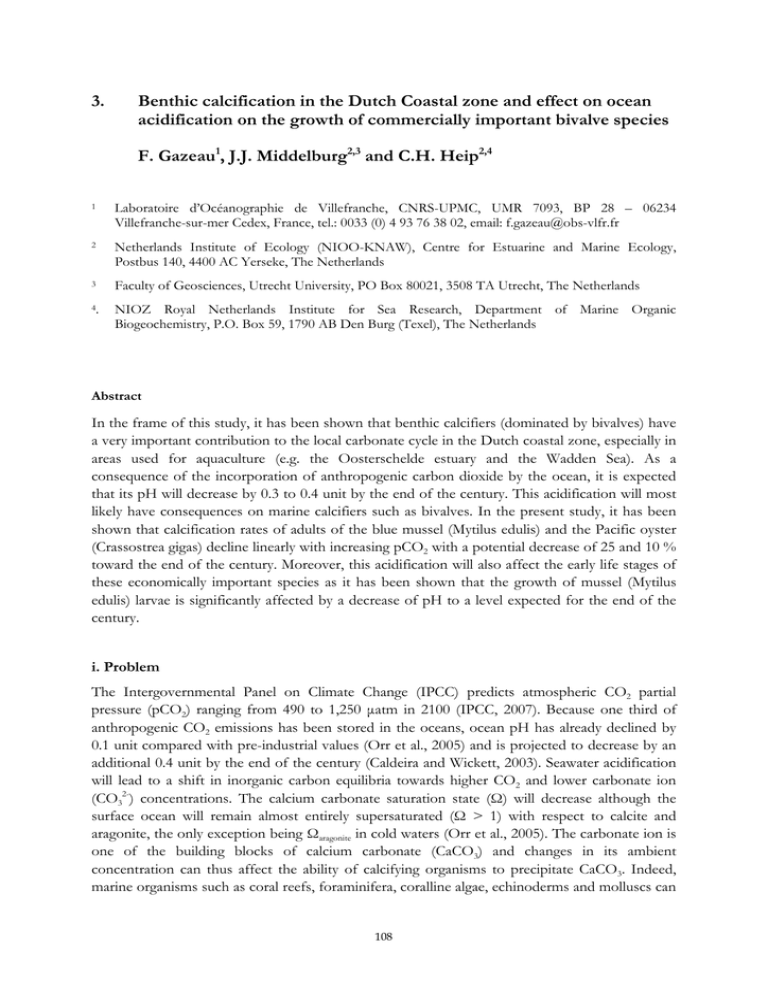
3. Benthic calcification in the Dutch Coastal zone and effect on ocean acidification on the growth of commercially important bivalve species F. Gazeau1, J.J. Middelburg2,3 and C.H. Heip2,4 1 Laboratoire d’Océanographie de Villefranche, CNRS-UPMC, UMR 7093, BP 28 – 06234 Villefranche-sur-mer Cedex, France, tel.: 0033 (0) 4 93 76 38 02, email: f.gazeau@obs-vlfr.fr 2 Netherlands Institute of Ecology (NIOO-KNAW), Centre for Estuarine and Marine Ecology, Postbus 140, 4400 AC Yerseke, The Netherlands 3 Faculty of Geosciences, Utrecht University, PO Box 80021, 3508 TA Utrecht, The Netherlands 4. NIOZ Royal Netherlands Institute for Sea Research, Department of Marine Organic Biogeochemistry, P.O. Box 59, 1790 AB Den Burg (Texel), The Netherlands Abstract In the frame of this study, it has been shown that benthic calcifiers (dominated by bivalves) have a very important contribution to the local carbonate cycle in the Dutch coastal zone, especially in areas used for aquaculture (e.g. the Oosterschelde estuary and the Wadden Sea). As a consequence of the incorporation of anthropogenic carbon dioxide by the ocean, it is expected that its pH will decrease by 0.3 to 0.4 unit by the end of the century. This acidification will most likely have consequences on marine calcifiers such as bivalves. In the present study, it has been shown that calcification rates of adults of the blue mussel (Mytilus edulis) and the Pacific oyster (Crassostrea gigas) decline linearly with increasing pCO2 with a potential decrease of 25 and 10 % toward the end of the century. Moreover, this acidification will also affect the early life stages of these economically important species as it has been shown that the growth of mussel (Mytilus edulis) larvae is significantly affected by a decrease of pH to a level expected for the end of the century. i. Problem The Intergovernmental Panel on Climate Change (IPCC) predicts atmospheric CO2 partial pressure (pCO2) ranging from 490 to 1,250 μatm in 2100 (IPCC, 2007). Because one third of anthropogenic CO2 emissions has been stored in the oceans, ocean pH has already declined by 0.1 unit compared with pre-industrial values (Orr et al., 2005) and is projected to decrease by an additional 0.4 unit by the end of the century (Caldeira and Wickett, 2003). Seawater acidification will lead to a shift in inorganic carbon equilibria towards higher CO2 and lower carbonate ion (CO32-) concentrations. The calcium carbonate saturation state (Ω) will decrease although the surface ocean will remain almost entirely supersaturated (Ω > 1) with respect to calcite and aragonite, the only exception being Ωaragonite in cold waters (Orr et al., 2005). The carbonate ion is one of the building blocks of calcium carbonate (CaCO3) and changes in its ambient concentration can thus affect the ability of calcifying organisms to precipitate CaCO3. Indeed, marine organisms such as coral reefs, foraminifera, coralline algae, echinoderms and molluscs can 108 produce calcareous skeletons or shells. As, at a constant salinity, calcium concentration is rather constant in the ocean, the calcification process mainly depends on the availability of CO32-. Since the seminal paper of Broecker and Takahashi (1966) reporting a dependency of calcification rates on CaCO3 saturation state, several experimental studies have investigated the effect of a pCO2 increase on the growth of calcifying organisms. At the start of the project, several experiments have shown a reduction of calcification at elevated pCO2 in corals, coralline algae, coccolithophorids, pteropods and foraminifera (Gao et al., 1993; Spero et al., 1997; Leclercq et al., 2000; Riebesell et al., 2000; Langdon et al., 2003; Orr et al., 2005). At that time, few studies have investigated the detrimental effect of acidic waters on benthic heterotrophic calcifiers such as molluscs and echinoderms (Bamber, 1990; Michaelidis et al., 2005; Berge et al., 2006). Finally, the contribution of coastal benthic calcifiers to the global carbonate cycle suffers from a serious lack of knowledge. An estimate of the future effects of ocean acidification on the global and regional carbonate cycle requires important efforts in that direction. ii. Aim In the frame of this project, we aimed at: 1) estimating the production rates of calcium carbonate in the Dutch North Sea and to identify the major contributors in this region 2) studying the effect of ocean acidification on two bivalve species of a great economic value for this region: the blue mussel and the Pacific oyster and, 3) as early life stages of calcifying organisms are generally considered to be more sensitive to environmental disturbances (Raven et al., 2005), conducting experiments on the effect of ocean acidification on the larval development of the two bivalve species cited above in collaboration with the commercial hatchery Roem van Yerseke (Yerseke, The Netherlands). iii. Results In order to estimate the calcification rates (production of calcium carbonate) of the major calcifying species of the Dutch coastal zone, several databases of macrobenthic distributions along the Dutch coast from the Netherlands Institute of Ecology (NIOO-CEME) and from the Netherlands Institute for Fisheries Research (RIVO) have been linked. Moreover, the database from the North Sea Benthos Survey (NSBS-ICES) performed in spring 1986 and covering the whole North Sea has been integrated (see Fig. C-3.1 for the sampling design). 109 Fig. C-3.1: Maps of the investigated areas showing the distribution of the sampling stations from which data of densities and biomass of the major benthic calcifiers were gathered (see text). A: Westerschelde estuary, B: Oosterschelde estuary, C: Wadden Sea, D: coastal North Sea and E: Dutch North Sea Empirical relationships linking size of the most abundant organisms and their shell weight have been established based on literature data. Rates of productivity for several species such as 110 mussels and cockles have been found in the literature and compared with rates estimated from our database, which has allowed estimating the calcimass production of these species in the Westerschelde, the Oosterschelde, the Wadden Sea and the coastal North Sea area. Additionally, the shell content of the sediment in the Southern part of the Dutch coast has been analyzed in order to provide insights into the accumulation rates (production-dissolution-export) of calcareous structures in this area. Results of this study, that shows a very important contribution of benthic calcifiers (dominated by bivalves) in areas used for aquaculture (e.g. the Oosterschelde estuary and the Wadden Sea) to the local carbonate cycle, are currently incorporated in a manuscript that will soon be submitted to an international peer-reviewed journal. Effects of ocean acidification on commercially important bivalve species (adults) A first study has been conducted at the Netherlands Institute of Ecology (NIOO-CEME) to assess the effect of ocean acidification on the net calcification rates of 2 ecologically and economically important species that are reared in Dutch coastal waters: the blue mussel (Mytilus edulis) and the Pacific oyster (Crassostrea gigas). This study, that has been published in a peerreviewed journal (Gazeau et al., 2007), has showed that the calcification rates of these 2 species decline linearly with increasing pCO2 (Fig. C-3.2). 111 Fig. C-3.2: Net calcification rates of Crassostrea gigas (Pacific oyster) and Mytilus edulis (blue mussel) as a function of seawater partial pressure of CO2 (adapted from Gazeau et al., 2007). Indeed, mussel and oyster calcification may decrease by 25 and 10 %, respectively, by the end of the century, following the IPCC IS92a scenario (740 μatm in 2100). Moreover, mussels dissolve at pCO2 values exceeding a threshold value of 1800 μatm. As these two species are important ecosystem engineers in coastal ecosystems and represent a large part of worldwide aquaculture production, the predicted decrease of calcification in response to ocean acidification will probably have an impact on coastal biodiversity and ecosystem functioning as well as potentially lead to significant economic loss. Effects of ocean acidification on the blue mussel larval development A study has been conducted at the hatchery Roem van Yerseke on the effect of ocean acidification on the larval development of the blue mussel (Mytilus edulis). This study that has been published in a peer-reviewed journal (Gazeau et al., 2010) has demonstrated that the growth of planktonic mussel (Mytilus edulis) larvae is significantly affected by a decrease of pH to a level expected for the end of the century (Fig. C-3.3). 112 Fig. C-3.3: Effect of ocean acidification on the larval development (first 2 days) of the blue mussel (Mytilus edulis). Empty bars: control pH (~ 8.1), black bars: low pH 1 (~ 7.8, oversaturation in aragonite), low pH 2 (~7.6, undersaturation in aragonite) (from Gazeau et al., 2010) Even though there was no significant effect of a 0.25-0.34 pH unit decrease on hatching and mortality rates during the first 2 days of development nor during the following 13-day period prior to settlement, final shells were significantly smaller at pH ~7.8 than at a control pH of ~8.1. More severe impacts were found with a decrease of ~0.5 pH unit during the first 2 days of development which could be attributed to a decrease of calcification due to a slight undersaturation of seawater with respect to aragonite. Although these results show that blue mussel larvae are still able to develop a shell in seawater undersaturated with respect to aragonite, the observed decreases of hatching rates and shell growth could lead to a significant decrease of the settlement success. 113 Effect of carbonate chemistry alteration on the early embryonic development of the Pacific oyster (Crassostrea gigas) Although several recent studies have shown decreased growth rates and increased proportions of abnormal development under low pH conditions (see for instance above), they did not allow attribution to pH-induced changes in physiology or to decreases in aragonite saturation state. This study aims at assessing the impact of several carbonate-system perturbations on the growth of Pacific oyster (Crassostrea gigas) larvae during the first 3 days of development (until shelled Dveliger larvae). Seawater with five different carbonate chemistry conditions was obtained by manipulating separately pH, total alkalinity and aragonite saturation state (calcium addition). Results showed that the developmental success and growth rates were not directly affected by changes in pH or aragonite saturation state but were highly correlated with the availability of carbonate ions (see Fig. C-3.4). Fig. C-3.4: Relationships between the average (±SD) shell length and area of D-veliger larvae as well as the amount of calcium incorporated at the end of the 72 h incubation period, and the average (±SD) conditions of the carbonate chemistry in the five treatments; pHT: pH on the total scale (left plots), Ωa: saturation state with respect to aragonite (middle plots) and [CO32-]: carbonate ions concentration (right plots). On the right plots, the dotted lines refer to the carbonate ions concentration at the aragonite saturation level (from Gazeau et al., submitted). 114 In contrast to previous studies, both hatching and growth rates were not significantly altered as long as carbonate ions concentrations were above aragonite saturation levels, but they strongly decreased below saturation levels. These results suggest that the mechanisms used by these organisms to regulate calcification rates are not efficient enough to compensate for the low availability of carbonate ions under corrosive conditions. This study has been submitted to an international peer-reviewed journal (Gazeau et al., submitted). iv. Conclusions In the frame of this project, for the first time, an estimate of the calcium carbonate production by benthic calcifiers has been carried out in the Dutch North Sea. This is the first regional study since Smith (1972) in Southern California. The calcifying benthic communities, in this area, are dominated by bivalve mollusks that are cultivated especially in the Oosterschelde estuary and the Dutch Wadden Sea. Several studies have been conducted in the frame of this project to assess the effect of ocean acidification on these economically important species. These studies revealed that both mussels and oysters are will be at risk in the coming decades. v. Recommandations In order to accurately predict the future of commercially important species in a high-CO2 world, research efforts will need to be made in order to: 1) investigate the cumulative effects of both warming and acidification on these species, 2) study their sensitivity to these perturbations under conditions that better reflect their natural environment (presence of predators, competitors etc.), 3) assess their capacity to acclimate and/or genetically adapt to such modifications of their environment. References Bamber, R. N. (1990). The effects of acidic seawater on 3 species of lamellibranch mollusk. Journal of Experimental Marine Biology and Ecology 143:181-191. Berge, J. A., Bjerkeng, B., Pettersen, O., Schaanning, M. T. and Oxnevad, S. (2006). Effects of increased sea water concentrations of CO2 on growth of the bivalve Mytilus edulis L. Chemosphere 62: 681687. Broecker, W.S. and Takahashi, T. (1966). Calcium carbonate precipitation on the Bahama Banks, Journal Geophysical Research 71: 1575-1602. Caldeira, K. and Wickett, M. E. (2003). Anthropogenic carbon and ocean Ph. Nature 425:365-365. Gao, K., Aruga, Y., Asada, K., Ishihara, T., Akano, T. and Kiyohara, M. (1993). Calcification in the articulated coralline alga Corallina pilulifera, with special reference to the effect of elevated CO2 concentration. Marine Biology 117:129-132. 115 Gazeau, F., Quiblier, C., Jansen, J.M., Gattuso, J.-P., Middelburg, J.J., and Heip, C.H.R. (2007). Impact of elevated CO2 on shellfish calcification, Geophysical Research Letters 34: L07603, doi:10.1029/2006GL028554. Gazeau, F., Gattuso, J.P., Dawber, C., Pronker, A.E., Peene, F., Peene, J., Heip, C.H.R. and Middelburg, J.J. (2010). Effect of ocean acidification on the early life stages of the blue mussel Mytilus edulis. Biogeosciences 7:2051-2060, 10.5194/bg-7-2051-2010. Gazeau, F., Gattuso, J.-P., Greaves, M., Elderfield, H., Peene, J., Heip, C.H.R. and Middelburg, J.J. (submitted). Effect of carbonate chemistry alteration on the early embryonic development of the Pacific oyster (Crassostrea gigas), PLoS ONE. IPCC (2007). Climate Change 2007: The Physical Science Basis. Contribution of Working Group I to the Fourth Assessment. Report of the Intergovernmental Panel on Climate Change. Edited by: Solomon, S., Qin, D., Manning, M., Chen, Z., Marquis, M., Averyt, K.B., Tignor, M., and Miller, H.L.. Cambridge University Press, Cambridge, United Kingdom and New York, NY, USA, 996 pp. Langdon, C., Broecker, W.S., Hammond, D.E., Glenn, E., Fitzsimmons, K., Nelson, S.G., Peng, T.H., Hajdas, I. and Bonani, G. (2003). Effect of elevated CO2 on the community metabolism of an experimental coral reef. Global Biogeochemical Cycles 17(1): 1011, doi:10.1029/2002gb001941 Leclercq, N., Gattuso, J.P., and Jaubert, J. (2000). CO2 partial pressure controls the calcification rate of a coral community. Global Change Biology 6:329-334. Michaelidis, B., Ouzounis, C., Paleras, A. and Portner, H.O. (2005). Effects of long-term moderate hypercapnia on acid-base balance and growth rate in marine mussels Mytilus galloprovincialis. Marine Ecology Progress Series 293:109-118. Orr, J.C., Fabry, V.J., Aumont, O., Bopp, L., Doney, S.C., Feely, R.A., Gnanadesikan, A., Gruber, N., Ishida, A., Joos, F., Key, R.M., Lindsay, K., Maier-Reimer, E., Matear, R., Monfray, P., Mouchet, A., Najjar, R.G., Plattner, G.K., Rodgers, K.B., Sabine, C.L., Sarmiento, J.L., Schlitzer, R., Slater, R.D., Totterdell, I.J., Weirig, M.F., Yamanaka, Y. and Yool, A. (2005). Anthropogenic ocean acidification over the twenty-first century and its impact on calcifying organisms. Nature 437: 681-686. Raven, J., Caldeira, K., Elderfield, H., Hoegh-Guldberg, O., Liss, P., Riebesell, U., Shepherd, J., Turley, C. and Watson, A. (2005). Ocean acidification due to increasing atmospheric carbon dioxide. The Royal Society policy document 12/05, The Cloyvedon Press, Cardiff, 58 pp. Riebesell, U., Zondervan, I., Rost, B., Tortell, P.D., and Morel, F.M.M. (2000). Reduced calcification of marine plankton in response to increased atmospheric CO2. Nature 407:364-367. Smith, S.V. (1972). Production of calcium carbonate on the mainland shelf of southern California. Limnology and Oceanography 17:28-41. Spero, H.J., Bijma, J., Lea, D.W. and Bemis, B.E. (1997). Effect of seawater carbonate concentration on foraminiferal carbon and oxygen isotopes. Nature 390: 497-500. 116
